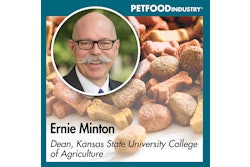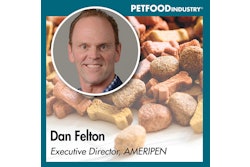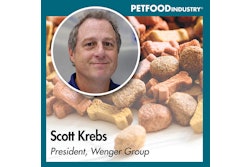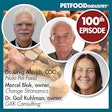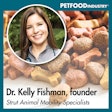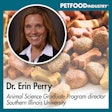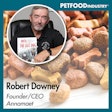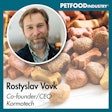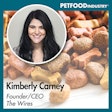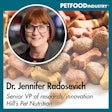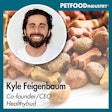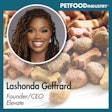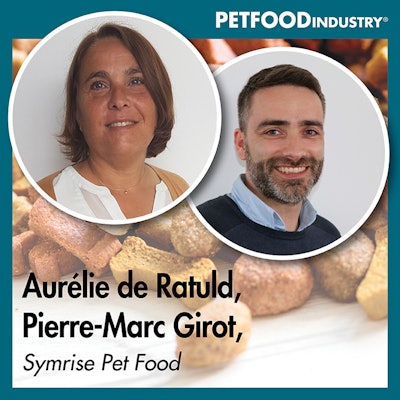
Symrise Pet Food's recent eco-design journey is explored with host Lindsay Beaton and Aurélie de Ratuld and Pierre-Marc Girot, both with Symrise, as they take a look at the steps the company took and tools used along the way.
The below transcript is from Episode 46 of the Trending: Pet Food podcast where editor Lindsay Beaton spoke with Aurélie de Ratuld, CSR director for Symrise Pet Food, and Pierre-Marc Girot, development and technical support manager for EMEA region at Symrise Pet Food, about their company’s eco-design journey and eco-tools you might be able to use on yours. You can find the episode at PetfoodIndustry.com/trending-pet-food-podcast, on SoundCloud or on your favorite podcast platform. This episode originally aired in October 2023.
Lindsay Beaton – Editor, Petfood Industry magazine and Host, Trending: Pet Food podcast: Hello, and welcome to Trending: Pet Food, the industry podcast where we cover all the latest hot topics and trends in pet food. I’m your host and editor of Petfood Industry magazine, Lindsay Beaton, and I’m here today Aurélie de Ratuld, CRS director for Symrise Pet Food, and Pierre-Marc Girot, development and technical support manager for the EMEA region at Symrise Pet Food. Hello and welcome.
Aurélie de Ratuld, CSR director for Symrise Pet Food, and Pierre-Marc Girot, development and technical support manager for EMEA region at Symrise Pet Food: Hello
Beaton: In case you're not familiar with my guests, here's what you need to know. Aurélie graduated with a degree in food science and has a PhD in biotechnology applied to aroma. With seven years of experience as a flavorist and biotechnologist, she joined Symrise Pet Food in 2000 to work on innovation projects for both cats’ and dogs’ palatability. She led R&D teams during more than 15 years on multiple topics from the regional implementation of product development teams to advance in disruptive research projects.
Aurélie was promoted in 2020 to CSR director of Symrise Pet Food. The CSR policy put in place is both complying with Symrise corporate sustainability goal policy and the requirements of pet food ecosystem specificities. The program covers a large range of topics including alternative sourcing, sustainable innovation, waste valorization, energy management, climate change, due diligence in the supply chain, responsible use of raw materials, and safety.
With a master’s in food science from agro campus in Brittany, Pierre-Marc joined Diana Pet Food in 2010 following his first role in technology research in Germany. He spent four years working at Diana Pet Food in Argentina as a research and development specialist. He later joined the company's headquarters in France to fulfill various projects as a technical expert supporting both internal and external customers. He is now the development and technical support manager for the EMEA region.
Symrise Pet Food is the global leader of sustainable high-value solutions, improving pets wellbeing and owner satisfaction. Thanks to the company's combined employee expertise, Symrise partners with pet food manufacturers to offer complete solutions covering three essential aspects of pet food: pet food palatability, pet nutrition and pet food protection. Symrise’s recent journey to reduce its CO2 emissions and a case study presented by the company on its journey to ecosustainability while producing palatents is why I've brought both Aurélie and Mark-Pierre on today to answer this question, what are the opportunities for eco-design in the pet food space? There are a lot of different sustainability conversations happening in the pet food space right now, so I want to start with a little bit of a 101 question. What is eco-design?
de Ratuld: Eco-design is a systematic consideration of the environment protection in the design of products and services. It's all about reducing needs of resources, preserve some of non-expendable resources, pay attention to the usage and to the end-of-life of the product. Eco-design is designing in the circular thinking and not anymore in a linear way of doing. We have to consider a product along its whole life, what is called cradle-to-grave.
This eco-design methodology is encompassed in methodology ISO norm set is all about the ISO 14,000 series of norms, and then it allows to run what is called a lifecycle assessment. It allows you to identify where the impacts are coming from when you have your products until its final usage. For instance, in agribusiness, 75% of the environmental impacts, including climate change and greenhouse gas emissions, are coming from the raw material production themselves. When we have a look at the raw product footprint, 90% is linked to indirect impacts coming either from the sourcing, upstream transportation, packaging or downstream transportation. Only 10% of impacts are due to the direct manufacturing of the products in our plants. That means at the end, eco-design will involve many actors. Among them, we can find the process teams, supply chain teams, R&D teams, but also operational teams.
Beaton: Those are important points to make and really important numbers to get out there because it's so easy in this conversation -- and we've been having this sustainability conversation in earnest for at least a few years now in the industry, right? -- but it's been a lot of high-level conversation. It is a lot easier, I think to focus on the more direct outputs, like packaging has been a huge part of the sustainability conversation from the start. Looking at the manufacturers and their end product and how the end product gets transported to where it's going to go and things like that.
But that's such a small part of the bigger picture of pet food, and the bigger picture of sustainability. It's interesting that you guys took that approach from the start and went, “Look, there is a lot that feeds into this that has nothing to do with the result or comes way before the end result. What do we need to do to ensure that we're looking at this entire picture?” Is that one of the things that appealed to you as a company -- the ability to just start at the beginning and go through and get a comprehensive look at things so that you could see what it is you really needed to do? Or was that a new approach for you guys?
de Ratuld: It was quite a new approach, but it was not done like that. In fact, there were some commitments that we had as a responsible company to address like, for instance, in terms of sustainability, responsible production, responsible portfolios and responsible sourcing. As a reminder, in 2015, there was the COP21 (Conference of the Parties to the Convention) where the nation setup for the Paris Agreement, aiming to reduce global greenhouse gas emissions. As a responsible company, we must commit to this agreement, because we are part of nations -- we are part of the ones that manufacture goods and then have to reduce greenhouse gas emission.
We started from nothing because it was new, but it was not new that we wanted to act as a responsible company. This is why having a full picture of where the greenhouse gas emission was coming from was particularly important to us to act at the right place at the right greenhouse gas action plan for efficient reduction.
You mentioned packaging, you mentioned manufacturing. So yes, it is important to act there because we have the hand on it. But it was in agribusiness more relevant also to consider all what was coming upstream. This was really for us the real responsibility of a company to be able to choose what we're putting in our products to supply the market with responsible products.
The second point of why we wanted to address that is that we wanted also to anticipate coming regulation. Already in 2018, there were a lot of trials that were done on product environmental footprint labeling. Also, there were a lot of things happening in Europe concerning greenhouse gas reduction on the European continent committed to reduce its greenhouse gas emission. A lot of regulations were pending, especially in France -- work was quite in advance. We didn't want to be too much in the hurry afterwards, to deliver some data on the market on the footprint of our products.
Girot: We had also some side benefits, let's say it so when we wanted to reach those targets, we had to consider new raw material, new ingredients. This at the end also helped us to diversify our supply and secure our sourcing. This is one of the type benefits and all the research also boosted our innovation. These new challenges were really motivating the team. It brings more sense to what they do in their daily work. It’s also very interesting working on scope one and two, we wanted to decrease our direct impact from our manufacturing plants. We saw some positive side effects that could also of course, reduce some of our costs.
Beaton: I remember thinking as you were presenting your case study, how incredibly complex and encompassing it looked. I was trying to think about the idea of a company really starting from scratch and going through this entire process in real time. I have to believe there were some challenges involved in that. What were some of the biggest challenges in taking this kind of thing on?
de Ratuld: The biggest challenge at the beginning was to know with what kind of thing we would start with. It's so complex. It's coming from the sourcing of the materials to the end of life.
What to start with? Let's take the example of what we did for our climate program. Our climate aim to participate to the reduction of our greenhouse gas emissions as part of a nation and in parallel with the Paris Agreement. I said before, we needed to find a tool to be able to measure the footprint of our products, but also to visualize concretely where it was coming from. To be able to compare some products, we had no idea of what was better than other thing, except ideas we had in mind that beef is not as good as pork or poultry, but no real data on that.
We also needed a tool to simulate some scenarios. What would be the effect changing the sourcing from this distance, but from another supplier that would be closer? The biggest challenge for us was to know where we were, where we stand. In 2018, we started by running lifecycle assessments on six different products on two different continents to have the global picture where the impacts were coming from. This is where we realized that most of them were coming from the sourcing. This is where we realized that the formulation itself would have a very strong impact on the final footprint of our product.
We developed the tool in order that the users have a visualization of the recipes, of course, have the percentage of each ingredient in the recipe that they already have. The contribution of this percentage to the final carbon footprint, for instance, and some very low amount of ingredient can have a very high contribution to the carbon footprint. In this tool, we asked a partner to have an easy-to-handle tool to visualize those contributions to ease the work of the product designer afterwards, so that they can improve where you have bad performance, for instance.
In 2019, we had this tool developed. We shared with the R&D team. Origins -- and it was funny because we shared with teams that we thought were eager to dig into carbon footprint -- and at the same time, there was a lot of pressure on this permeability of the raw materials, increasing the price, a lot of constraints everywhere. There were some civilized on the impact climate change everything, so it was perfect. They received the message coming to the tool. They found that it was a very nice tool. The reaction, however, was, “What? Another constraint in the product development?” I was a little bit disappointed, because they were also feeling kind of isolated, because they were thinking that they had order jobs to be done by R&D teams to reduce greenhouse gas emissions, whereas we forgot to tell them that some of the work could have been done by the process team, some of the work could be done by the supply chain, etc.
At that time, we were not mature enough to show the R&D teams using this eco-design matrix tool that they were not alone in this low-carbon journey. This is where it was maybe missing to have the global program, low-carbon programs, that we started to implement in Origin. But at that time, we had not the real objective concerning the reduction.
Girot: When we had these additional targets – we were at the beginning a little bit reluctant, because we saw that as additional technical constraints to fulfill. That could bring, of course, more complexity to our development. We were already rather long in our development phases. We were thinking that it would add some additional work. We will also, of course, lower our rate of success to launch a product. The good thing is the tool was so easy to use. What we did, so we used it from the beginning. We assessed our complete portfolio. For every new development, we were playing with that tool to really assess the impact the footprint of this new development. We did that for about one or two years, then we realized that it was something feasible to reach this additional target. In addition to performance to availability to cost -- to add this was a constraint and this constraints on the environment, because sometimes it goes hand in hand with some additional objectives. We realized that it was something that we could do -- we learned by doing clearly. Then we realized that we were up to the challenge. Later in 2022, we had clear objectives coming from our top management, where we understood that our goal was to reach minus 30% of carbon emission Scope 1, 2 and 3 by 2030. Having at that moment a weekly objective, we were willing to take this challenge. We were in that moment ready and motivated, because we knew we had some knowledge already, and we had the tool to help us to realize this objective.
Beaton: What did Symrise end up getting out of this whole process that might have been surprising? Obviously, the process was worth it, you've given a bunch of reasons why in terms of preparedness, in terms of being a responsible company. How has this entire process elevated Symrise from a business perspective? Has it flowed out into your partners in the industry?
de Ratuld: Not easy to answer, because there are things that can seem we had expected already, but were achieved, but maybe for another company, it could have been unexpected. What I mean is that we already have R&D teams that are open to change. This is something that we can start with. What was unexpected is learning-by-doing made them so confident that now it's really part of the daily job.
What we can say that is that today, we have a “pushing team” in R&D whose message to the others is that it's possible to be done. Another unexpected outcome is that between 2019 when we launched the eco-design metric tune internally, and today, there were a lot of things that were implemented at the European level. For instance, maybe you heard about it about the taxonomy concerning climate change? We were not aware of that. It would have been so useful to have this methodology and daily work on greenhouse gas reduction. Whereas today, it's possible for us to target some project or to tax on OPEX, or capex, or even sales for which we can demonstrate that we had specific actions and action plans to reduce greenhouse gas emission. We can explain that to our investors. It is really something that is unexpected, because we didn't plan that the taxonomy would have been put in place so quickly. Then we are not late at all, we are even a little bit ahead.
Girot: We have also some questions coming from many of our customers. I think it's rather new, and I was not expecting so many questions so early. Really this year, we have many questions from our regional European customers. Before, we had more questions coming from the global companies. Now, it's more up to the region. They asked many questions and we are ready to give these answers. Even more than those data. You are also capable of sharing our methodology and are really eager to know how you could assess all this so we can really share the way we are measuring all this and obviously gives us a competitive advantage.
Beaton: What advice do you have for any other companies that might be considering doing something like this? Because it is a big undertaking, it does take a while, and it can be complex depending on where you are in the supply chain. Where do you think it would be best for people to start? What are the initial questions they need to ask themselves so that companies can be set up for success to do something like what Symrise has done?
de Ratuld: We can speak only from our own experience, but my first advice would be keep it simple. There is an expression in French, "usine à gaz” -- it's a gas factory (used to describe any incomprehensible system). If you want to do everything at the same time, for every emission center of your business, it’s just impossible. It will be too complex.
You must first know the main contributors to your greenhouse gas emissions and to focus on that. If it's 80% of your emissions, it's enough. Don't pay attention to something that is less than 2%. Even if it can federate some people about commuting or whatever the commuting in the company is less than 1% of the greenhouse gas emissions. It's good to federate the people around one topic such as mobility, but let's focus on what makes a most of your emissions.
The second point is to work in a giant mode. What does it mean? Concerning the tool, if you must build a tool, let's focus on the main functionalities that you want first. This was the one for R&D for us. In 2021, we opened new functionalities for marketing. We will open functionalities to this tool for process teams. But first, let's do it for the main functionality you are looking for.
My third piece of advice, because it's a world where the things are changing a lot, is if you can, it's good to be part of pet food federations in your countries. This is where you can follow how the regulation is evolving. It's important to participate in those technical, regulation or environmental groups. You will be together with other pet food actors, and you can contribute to build some standards. You can contribute to be aware of what will come for your business in the different countries. Europe is a big doer of a new regulation. But China and the U.S. will follow. It's good to be aware -- to have specific tools or to consider all what will come.
Girot: Also very key -- the top management involvement to get real push from there to understand that this is really a high priority. If the company wants to survive and grow, it must grow sustainably. Also, set very clear objectives by department and by function to understand -- what is my role? How can I contribute to this target? And how can I meet those two things?
de Ratuld: Yes, you're right. I think we can take some examples of companies that have put in place some low-carbon programs, and we know that specific objective per department is really key. Even getting incentives on the remunerations of the people on climate is also pushing some people when you have some discrepancies on the understanding on what is climate change, according to the countries, so it aligns all the people. Having clear objectives is really key.
Beaton: I think that is all excellent advice. And considering I have listeners all along the supply chain and in all different parts of the pet food business, I think you guys have covered well where different entities at different points in the supply chain can really begin to make a difference with this sort of thing, which is why I really appreciate you both taking the time to sit down with me today.
There are a lot of different sustainability conversations happening right now in the pet food space. When I first saw the Symrise case study presented, I was fascinated by the all-in approach you guys took to bringing eco-sustainability on board, and I wanted to share that with my audience. Thank you so much for being on.
de Ratuld and Girot: Thank you.
Beaton: Before we wrap things up, let's do a little plug. Where can people find more information about you as well as Symrise Pet Food?
Girot: We have a website, of course, which is pet food that symrise.com. You can follow us on LinkedIn, where you can find all our latest news or events, all the latest publications -- everything that matters.
Beaton: Excellent. That’s it for this episode of Trending: Pet Food. You can find us on PetfoodIndustry.com, SoundCloud or your favorite podcast platform. You can also follow us on Instagram @trendingpetfoodpodcast. And if you want to chat or have any feedback, I'd love to hear from you. Feel free to drop me an email: [email protected]. Once again, I'm Lindsay Beaton, your host and editor of Petfood Industry magazine, and we'll talk to you next time. Thanks for tuning in!



